








Robex seminars

|

|

|

|

|

|

|

|

|

Title : Interval-based fault-detection of GNSS signal using land-based cameras for remote ship piloting operations
Abstract.
Ensuring remote human oversight of Maritime Autonomous Surface Ships (MASS) during
critical situations poses a key technological challenge: the human pilot must largely rely on
sensor data transmitted from the ship to maintain situational awareness and assess risks such as
collisions or groundings. However, this data can be degraded or falsified, jeopardizing decision-
making and safety. To address this issue, we propose a method to enhance the resilience of
situational awareness by cross-validating onboard sensor data with independent observations
from land-based sensors. Specifically, we investigate the use of land-based stereo cameras to
provide an external estimate of a ship’s trajectory, which is compared with the trajectory
derived from the ship’s satellite compass. Interval analysis is employed to quantify and detect
inconsistencies between the measured and estimated vessel positions. To evaluate the approach,
synthetic dégradations are introduced into the ship-based estimates, and the system’s ability
to identify these anomalies is assessed. The results demonstrate the potential of shore-based
sensing as a complementary validation layer for resilient remote supervision of MASS.
Title : An overview of ADRC control, original and modern versions. A short review of power electronics, mechanical and vehicles applications
Abstract.
Among the significant advancements in control theory, one strategy has garnered considerable attention from the academic community due to its numerous advantages:
Active Disturbance Rejection Control (ADRC). This strategy has been developed over the past decades and has been applied in a wide range of fields,
from mechanical systems to navigation for various types of vehicles. This seminar will cover the foundations of ADRC, explore different representations,
and examine modern applications that highlight the capabilities and robustness of this control scheme.
In particular, it will present examples from electrical, electromechanical, mechanical, and vehicular domains, including an application
for the Hovercraft system and a general case for Underactuated Surface Vessels.

Title : Accelerating the SIVIA algorithm with GPU
Abstract.
This presentation addresses the problem
of accelerating the SIVIA algorithm with GPU. The implementation
is performed using the Julia language.
An example related to TDOA localisation is presented.
The comparisons show the benefit of using GPU in the context of interval analysis.
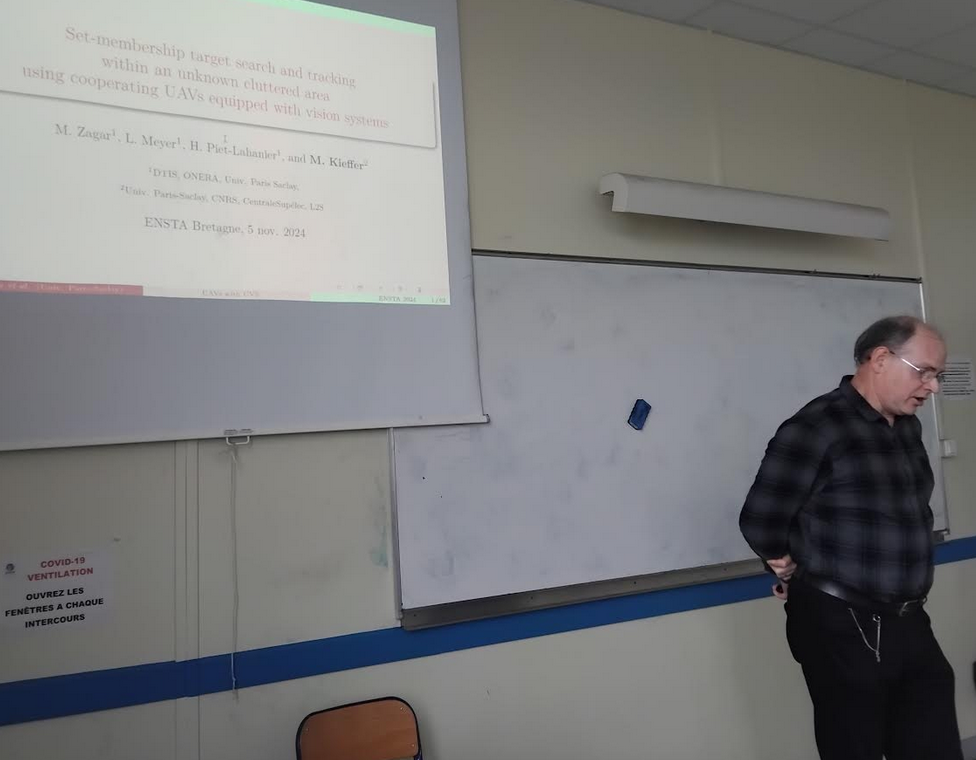
Titre : Target Search and Tracking in an Unknown Environment by a Fleet of UAVs using a Set-Membership Approach
Collaborators : Maxime Zagar, Hélène Piet-Lahanier et Luc Meyer.
Abstract.
This presentation addresses the problem of search and tracking an unknown number of mobile ground targets within an uncharted Region of Interest (RoI)
using a fleet of cooperating Unmanned Aerial Vehicles (UAVs). Each UAV embeds a Computer Vision System providing images with labeled pixels,
depth maps, and bounding boxes around identified targets. This information is used by a set-membership estimator to characterize sets guaranteed
to contain the locations of already identified targets and a set containing the locations of all targets remaining to detect.
A map of the unknown environment is constructed during search to favor exploration of areas previously occluded by obstacles.
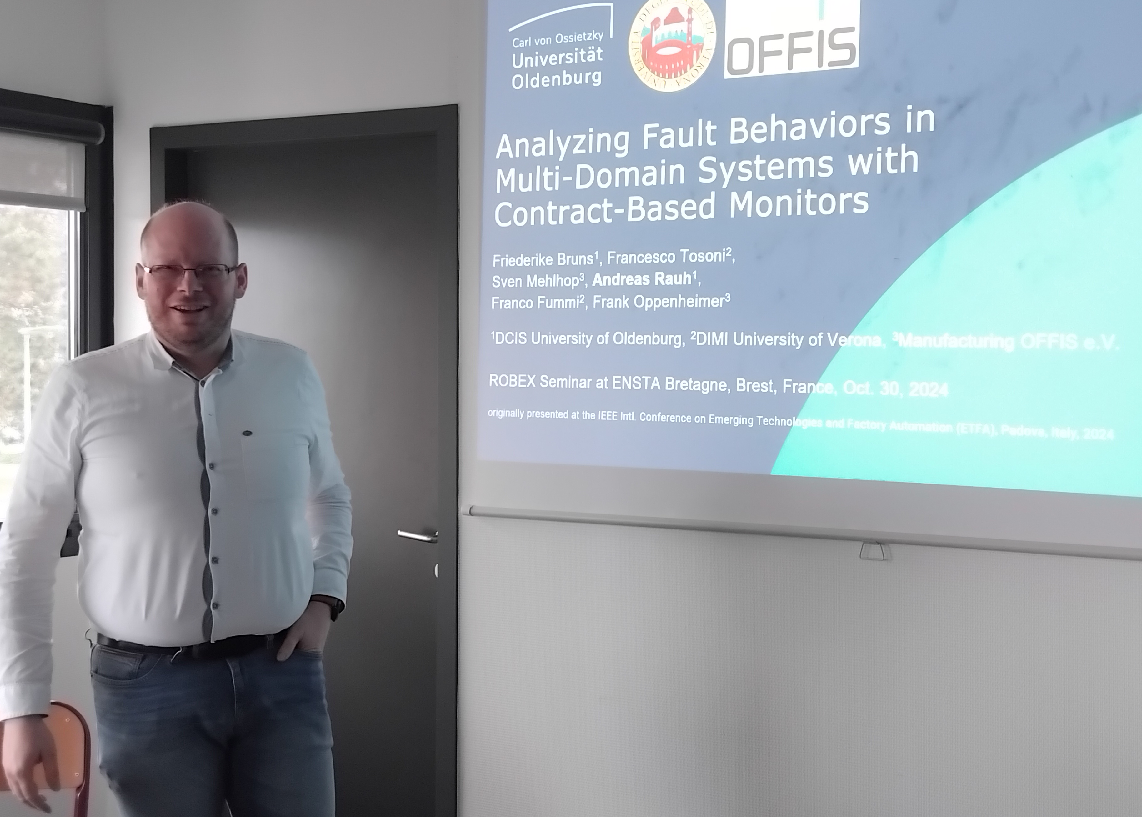
Titre : Analyzing Fault Behaviors in Multi-Domain Systems with Contract-Based Monitors
Collaborators : Friederike Bruns, Francesco Tosoni, Sven Mehlhop, Franco Fummi, Frank Oppenheimer.
Abstract.
Industrial control systems need to be highly reliable and precise at
all times to ensure operational efficiency and prevent costly
downtime. Early fault detection is crucial and is partially realized
by runtime monitoring components. A correct-by-construction approach
based on contract specifications allows early intervention in case of
potential faults. In this paper, we suggest to combine the
time-sensitive behavioral contracts with a multi-domain system model
specifically designed for fault injection to improve the model as well
as the contract specification at design time. This allows for early
detection of potential faults and a more reliable system specification
based on the analyzed behavior. We successfully realized a
co-simulation environment comprising a fault-injection tool and
contract-based monitors. We discussed the proposed approach using the
example of a DC motor highlighting the benefits and potential
enhancements of this systematic methodology.
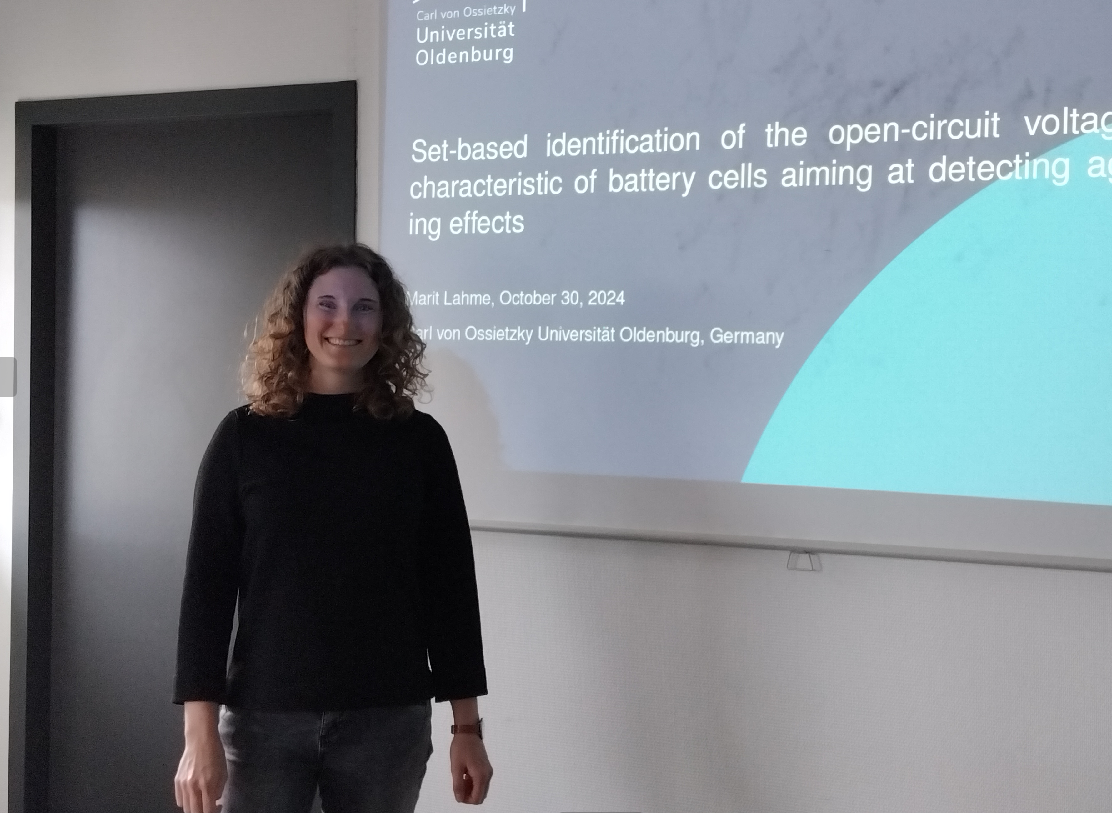
Titre : Set-based identification of the open-circuit voltage characteristic of battery cells aiming at detecting aging effects
Abstract.
Lithium-ion batteries are currently used in numerous applications, for example, in electric vehicles and stationary energy storage systems.
Accurately estimating the dynamic behavior is crucial to safely and efficiently charge and discharge the battery cells.
This can be done, for example, with the help of the open-circuit voltage characteristic of the battery cell which represents
the nonlinear relationship between the state of charge and the open-circuit voltage. Typically, the identification of the
open-circuit voltage characteristic is done offline and requires a lot of time due to necessary relaxation times.
In this seminar, an online interval-based identification routine is presented, which can be used in real-time applications.
The presented approach consists of two stages.
The first stage is a model-based state estimation with an interval observer and the second stage is a set-based identification of the nonlinear open-circuit voltage characteristic.
The overall goal of this work is, to use the presented identification approach for detecting aging effects in the battery cells. This knowledge can afterwards be used
in battery management systems to enhance the state of health estimation, to optimize the charge and discharge strategy or to improve the cell balancing.
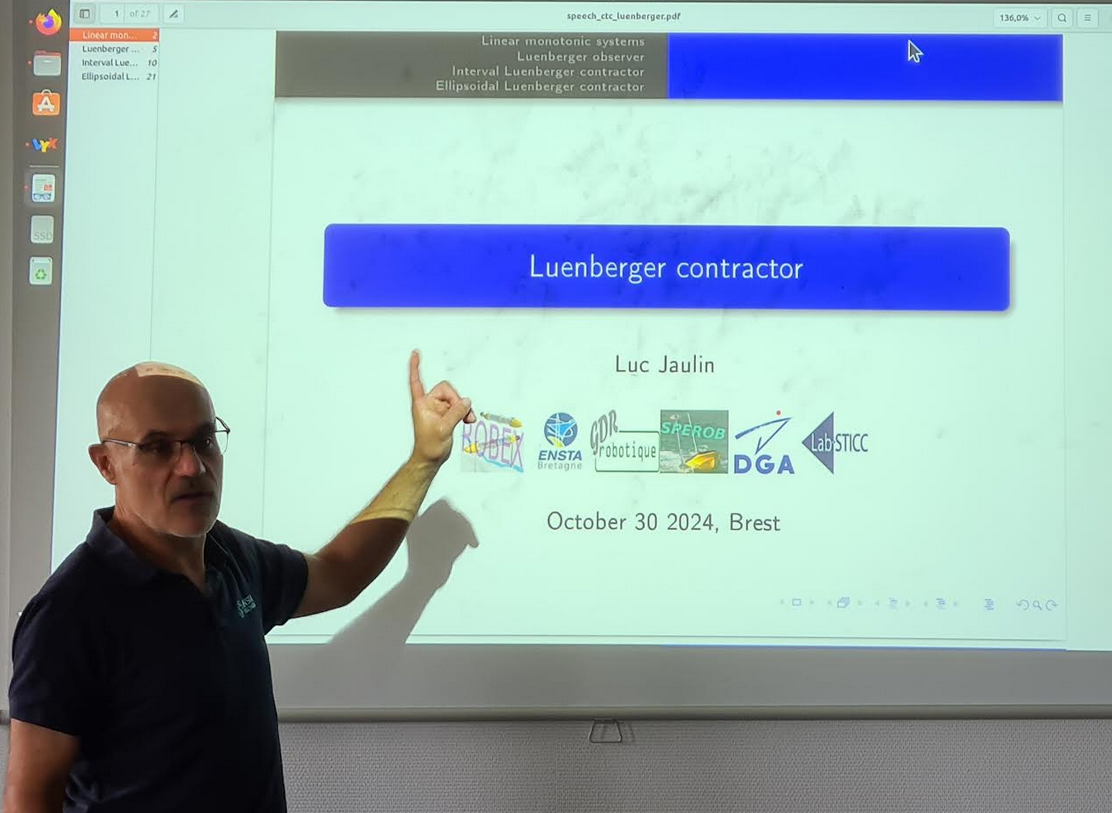
Titre : The Luenberger contractor
Abstract.
In this presentation, I show how the classical Luenberger observer can be used to build an efficient interval tube
contractor for constraints described by linear differential equations.
I will also explain how the approach can be used to propagate forward in time an ellipsoid in the state space.
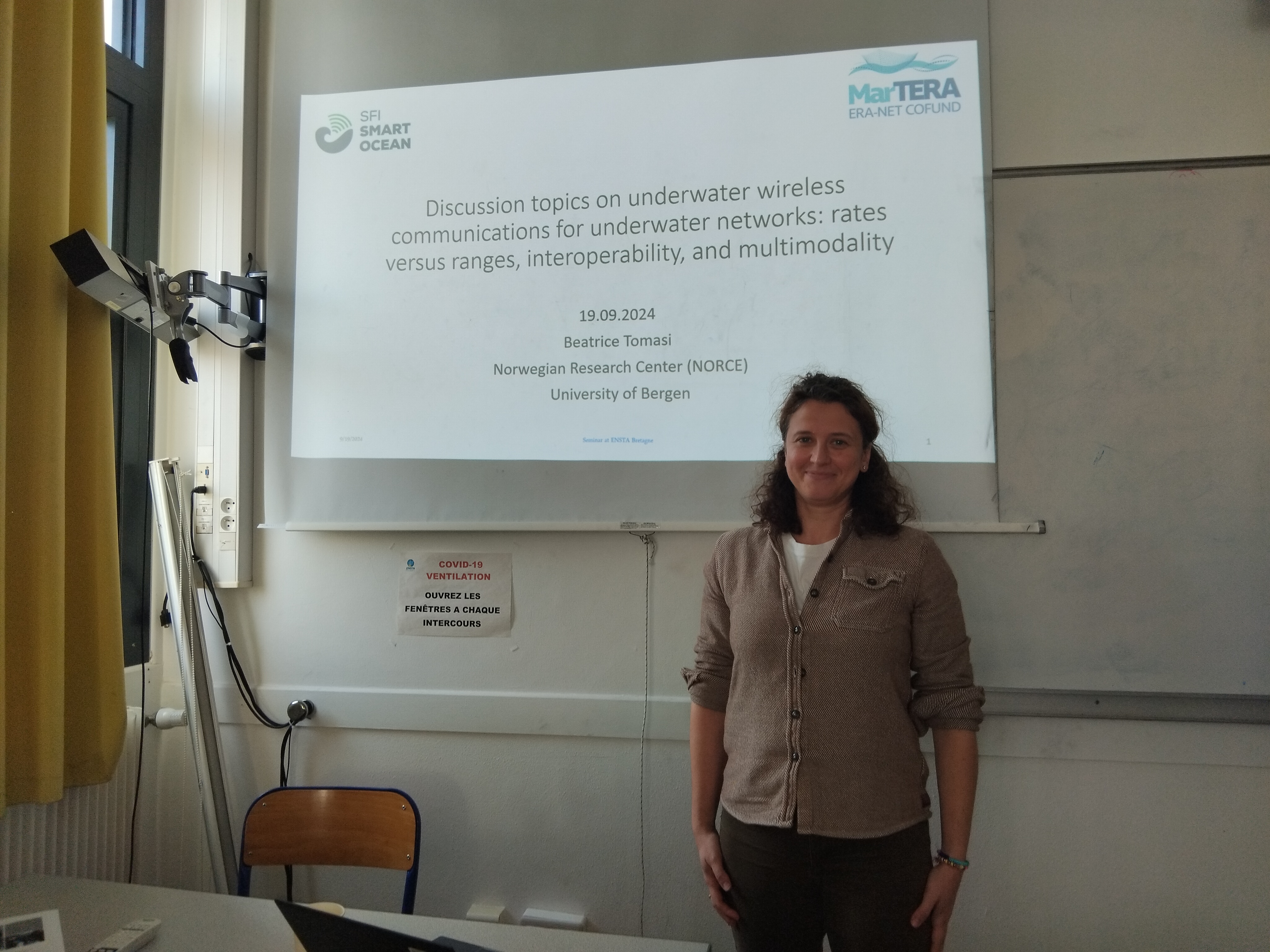
Titre : Discussion topics on underwater wireless communications for underwater networks: rates versus ranges, interference avoidance, interoperability, and multimodality
Abstract.
This talk will provide some points of discussion based on the recent results from the Center for Innovation – Smart Ocean, and MarTERA UNDINA research projects,
held in collaboration between academia and underwater technology companies. Questions such as how far and how much information could be wirelessly transferred underwater,
how to avoid interference across multiple active acoustic sources, and how to qualify interoperability across different modems will be addressed through
physical modelling and by showing experimental research results.
Biographie. PhD in Information technology and Science from University of Padova in 2012, B. Tomasi has academic and industrial working experience
in the domain of underwater and wireless technology. Among the workplaces where she contributed are Woods Hole Oceanographic Institution (USA),
Huawei Mathematical and algorithmic labs (France), ISEN Yncrea Ouest (France), University of Bergen (Norway) and Norwegian Research Center (Norway).
Her research interests are underwater mobile networks, underwater communication standards, and resource constrained underwater communication and positioning systems.
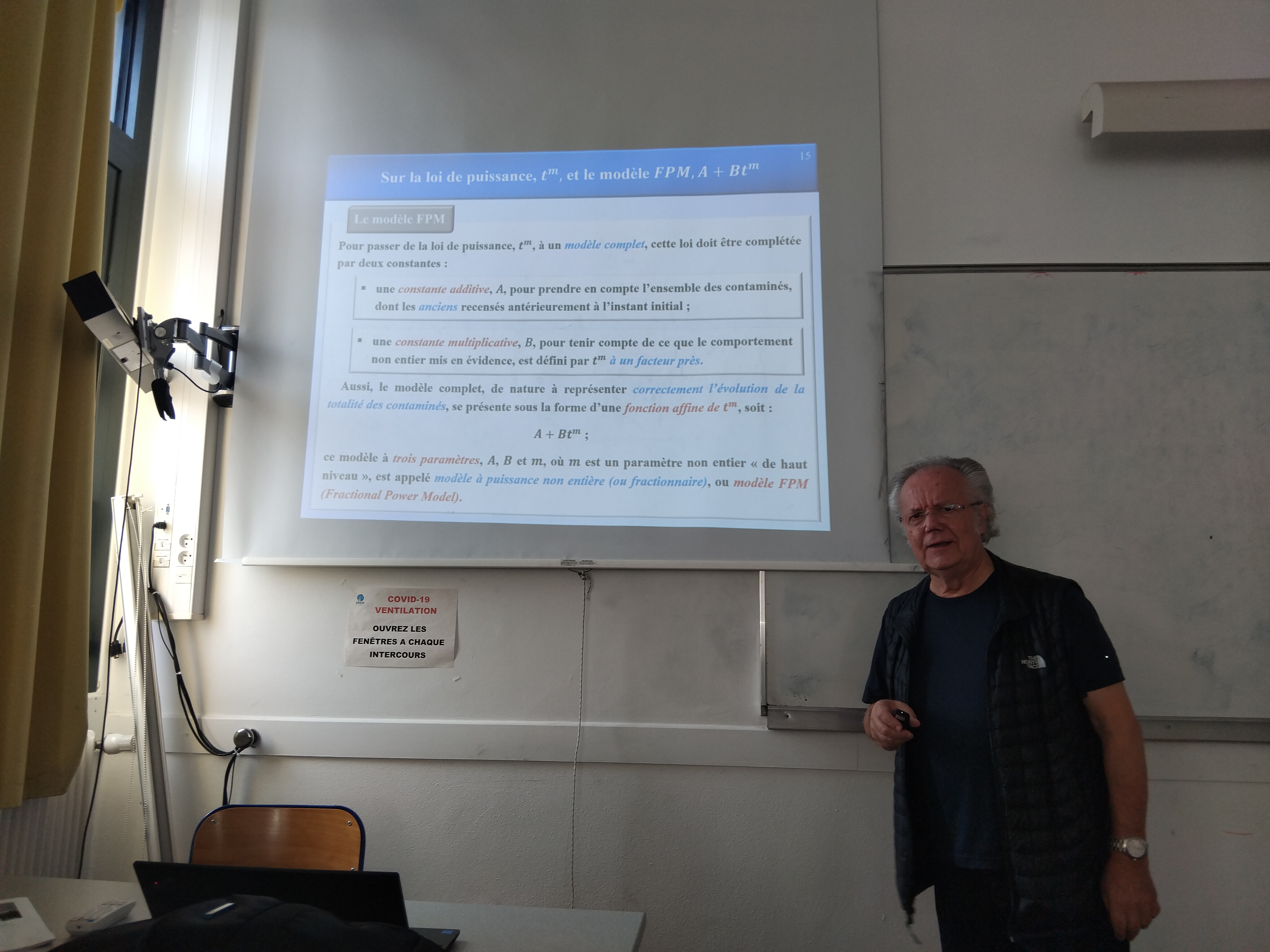
Titre : D’une nouvelle approche en propagation virale à des prédictions en pollution atmosphérique
Abstract.
Reconnu comme "Fait marquant 2021 du CNRS", le modèle FPM (Fractional Power Model) qui généralise la régression linéaire est un modèle à trois paramètres
dont la puissance indique à elle seule la progression, la stabilisation ou la régression d'une épidémie.
Par sa puissance non entière, ce modèle contribue à l'unification des phénomènes de diffusion en physique et de propagation virale en épidémiologie.
Sa représentativité (des données réelles) est due à sa capacité de prendre en compte un nombre illimité de dynamiques internes de rapidité différente.
Le modèle permet ainsi de représenter toutes les dynamiques internes d'une épidémie, des plus lentes, issues des campagnes très désertifiées,
aux plus rapides, issues des grandes villes très densifiées. Sa prédictivité est due à sa capacité de prendre en compte tout le passé en le pondérant comme il convient.
Le modèle est en effet doté d'une forme prédictive à mémoire longue qui exprime que toute valeur prédite est une fonction de toutes les valeurs passées,
valeurs qui s'avèrent favorablement pondérées selon un facteur d'oubli (qui n'est pas sans évoquer une forme subtile de mémoire). Le modèle présente ainsi
l'avantage d'utiliser au mieux le passé, d'autant que seul le passé peut être utilisé pour prédire le futur, en fait, une spécificité prédictive de nature à faire de ce modèle
un bon prédicteur pour les décideurs. La représentativité du modèle a été validée avec les données officielles du Ministère Français de la santé sur la propagation du COVID-19,
notamment les séries temporelles des contaminations et des hospitalisations. Sa prédictivité a également été validée par des prédictions vérifiées dans des phases
de confinement et de vaccination, et même pour la vaccination elle-même. Enfin, le modèle est aussi validé par des prédictions vérifiées et en sa faveur,
menées dans le domaine de la pollution atmosphérique.
Biographie. Diplômé de l'ENSEIRB en 1973, Alain Oustaloup est actuellement professeur émérite à l'ENSEIRB-MATMECA - Bordeaux INP.
Après avoir synthétisé la dérivation ou intégration non entière complexe, puis surmonté le dilemme stabilité-précision en automatique et le dilemme masse-amortissement en mécanique,
il invente la commande CRONE et la suspension CRONE. Plus récemment, il récidive en proposant un nouveau prédicteur, à puissance non entière, qu'il applique en épidémiologie
et en pollution atmosphérique. Ses travaux ont été récompensés par une Médaille d'Argent du CNRS en 1997 et un Grand Prix de l'Académie des sciences en 2011.
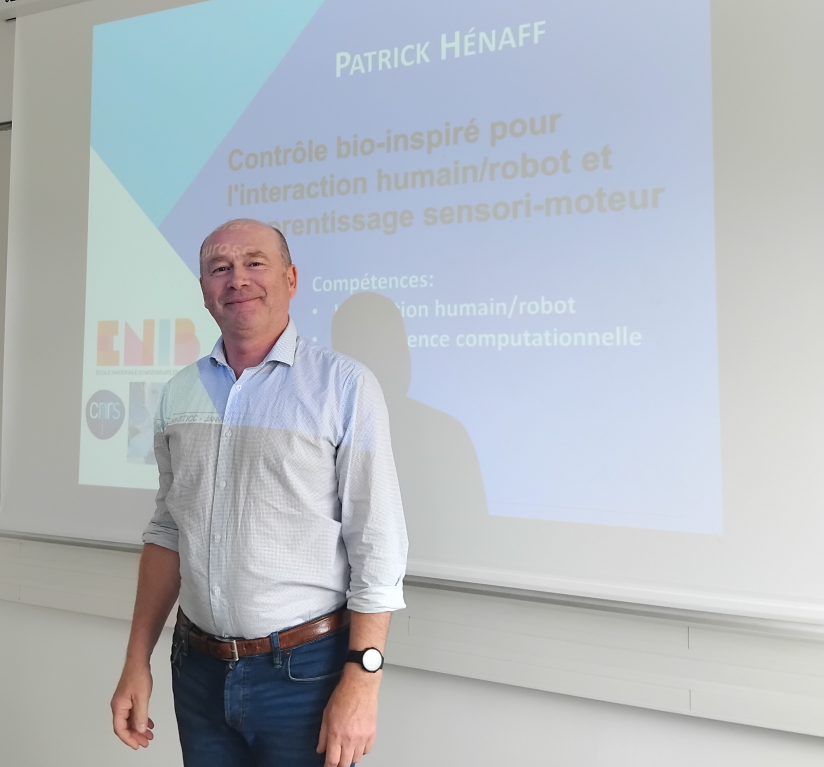
Titre : Contrôle bio-inspiré pour l'interaction humain/robot et l'apprentissage sensori-moteur
Mots-clés : Robotique humanoïde, contrôle neuronal, générateur de motifs centraux (CPG), coordination sensorimotrice, interactions homme/robot.
Abstract.
La présentation portera sur l'utilisation de contrôleurs de robots bio-inspirés basés sur le fonctionnement de boucles sensori-motrices biologiques
spécifiques qui contrôlent les mouvements rythmiques des mammifères. Ces boucles sont basées sur des structures de réseaux neuronaux,
appelées central pattern generators (CPG), qui sont impliquées dans la genèse et l'apprentissage de mouvements rythmiques adaptatifs.
La particularité des CPG est qu'ils fonctionnent comme des ocscillateurs non linéaires à relaxation dont les principes sont
à la base des modèles de CPG.
En robotique interactive physique et sociale, il est intéressant de mieux comprendre et modéliser ces structures afin d'avoir des robots
humanoïdes capables d'apprendre des mouvements rythmiques pour l'interaction avec les humains.
Après une brève introduction sur les CPG biologiques et les mouvements rythmiques, nous introduirons le concept de synchronisation,
un principe sous-jacent à l'interaction physique et sociale entre les humains et présent dans les oscillateurs dynamiques.
Différents modèles de contrôleurs de robot à base de CPG seront présentés notamment pour des applications à la locomotion des robots.
La deuxième partie de l'exposé présentera plusieurs expériences d'apprentissage de coordination motrice par un robot qui interagit avec un humain.
Plusieurs vidéos de simulations et d'expériences illustreront la présentation. Une conclusion et des perspectives concluront l'exposé.
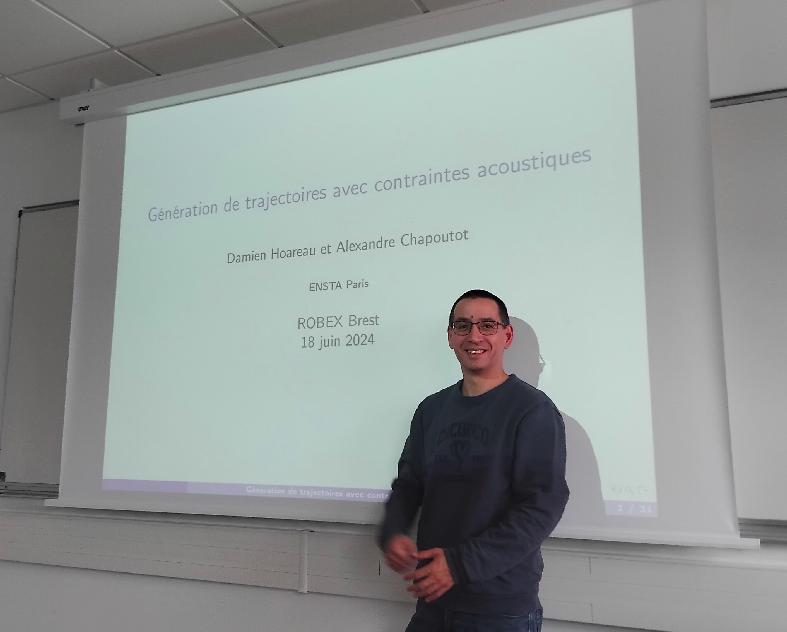
Titre : Génération de trajectoires sous contraintes acoustiques pour les drones
Abstract.
An optimization-based trajectory generation method for unamed aerial vehicles (UAV) with the integration of acoustic constraints will be presented.
Solving the acoustic pressure field of an UAV to limit its acoustic signature in space is very challenging if embedded in real-time algorithms.
High computational costs are often necessary and the acoustic model depends on many parameters.
Nevertheless, new methods allow to interpret localized acoustic pressure field as exclusion zones in space limiting the need of computations.
The proposed method considers these zones as acoustic obstacles that UAV should avoid. This approach allows a seamless integration in optimal control problem formulation for which state of the art solvers can be used.
Convex optimization methods such as the successive convexification algorithm (SCvx) solve in polynomial time non-linear optimal control problems.
Convergence properties and initial conditions flexibility offer a great robustness. In addition, co-computation of UAV trajectory and control inputs is a real asset. Preliminary results show that the proposed approach is promising.
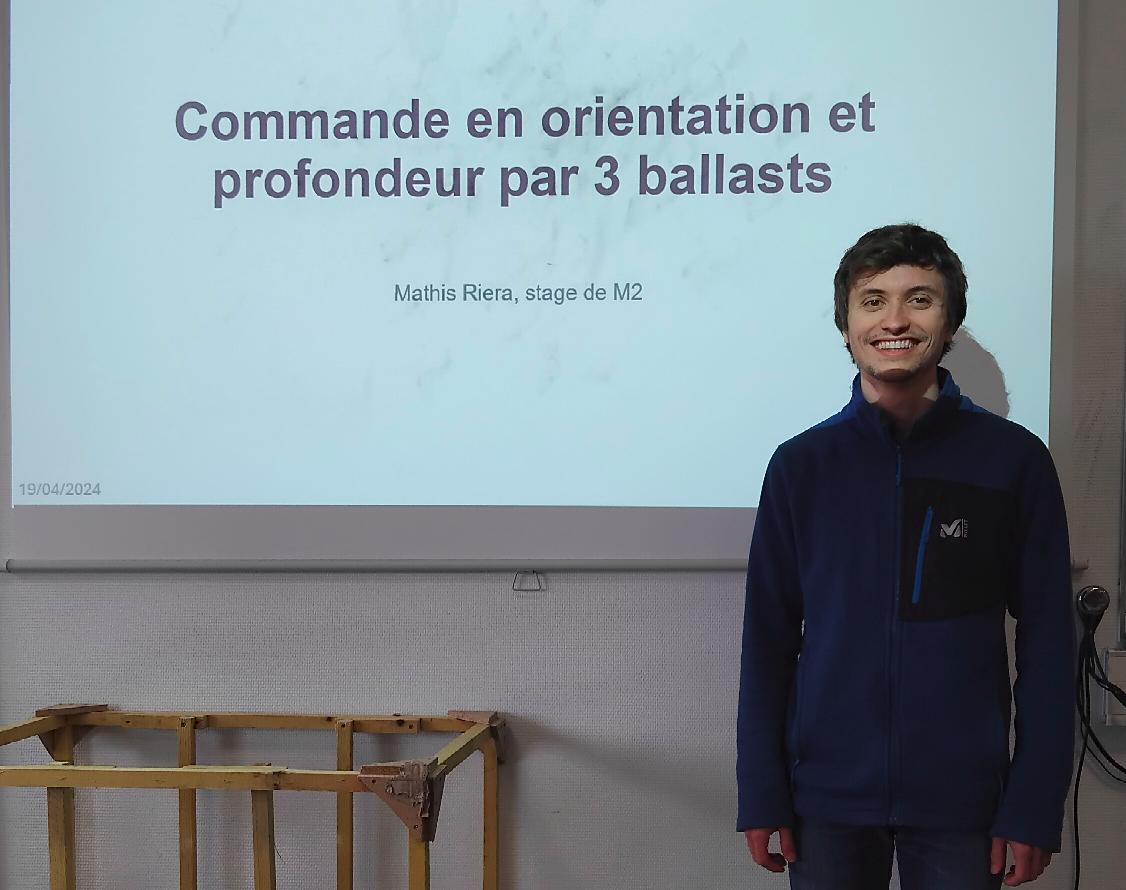
Titre : Commande en profondeur et orientation complète par 3 ballasts
Résumé. L'objectif de l'étude est de commander un robot uniquement actionné par 3 ballasts afin de le stabiliser à une profondeur et une orientation donnée.
On cherche à stabiliser une orientation complète (3 angles d'Euler), incluant donc le cap, dans la limite de ce que permet l'actionnement par 3 ballasts.
Les points suivants sont abordés :
- Étude des orientations atteignables et stables en fonction de la configuration du robot (position et masses des ballasts, masses et équilibrage du robot);
- Commande du robot en linéarisation par bouclage, le stabilisant d'abord à une profondeur et une orientation incomplète sans prise en compte du cap;
- Proposition d'une stratégie de commande en cap permettant d'orienter complètement le robot.
Les ballasts ne permettant d'appliquer un effort que dans une direction verticale, le cap ne peut pas être contrôlé de manière directe.
Une stratégie combinant une succession de rotations menant à l'orientation en cap est donc proposée. La commande proposée est vérifiée et illustrée par simulation.

Titre : Processus décisionnel autonome en présence d'informations incomplètes et de règles de sécurité basé sur un raisonnement non-monotone
Résumé. Dans ce séminaire, nous allons présenter une proposition d'un processus de décision intégrant un raisonnement non-monotone (NMR),
embarqué dans une architecture délibérative pour un robot sous-marin. Le processus NMR se fonde sur la logique des défauts afin d'implémenter
un raisonnement par objectifs, prenant en compte des informations partiellement observables et/ou incomplètes, et permettant la conception
de comportements par défaut qui sont complétés par le traitement de situations spécifiques, afin de gérer l'objectif de la mission en cours ainsi que les règles de sécurité.
Nous illustrons notre approche dans le cas d'un robot sous-marin effectuant une mission dans le cadre de la biologie marine.

Titre : Dessin rapide à haute résolution de courbes et surfaces algébriques
Résumé. La visualisation scientifique permet aux utilisateurs de développer une intuition sur leurs données et de les comprendre.
Nous abordons le problème de la visualisation de courbes et de surfaces algébriques implicites, qui sont solutions d'une équation polynomiale
P(x, y) = 0 ou Q(x, y, z) = 0. Plus précisément, nous traitons le problème du tracé de courbes ou de surfaces de haut degré en haute résolution.
Dans ce cas, la plupart des approches de l'état de l'art ne parviennent pas à produire des dessins en un temps raisonnable en raison du coût élevé de l'évaluation polynomiale.
Notre principale contribution consiste à combiner des algorithmes standards de visualisation issus de l'infographie
avec des méthodes d'évaluation multipoints issues du calcul formel. Plus précisément, nous utilisons la transformée
en cosinus discrète (DCT), qui peut être calculée efficacement avec l'algorithme de transformée de Fourier rapide (FFT).
Dans la plupart de nos algorithmes, nous avons combiné cette idée avec un processus de subdivision classique afin de réduire le nombre d'évaluations.
En utilisant un calcul exact de borne d'erreur et l'arithmétique d'intervalles, nous proposons de nouveaux algorithmes qui produisent des dessins certifiés.
Nous les comparons expérimentalement sur deux classes de polynômes de haut degré. En particulier, certaines de ces approches sont plus rapides que les logiciels de l'état de l'art.

Title : Examples for the use of the Intlab and Cora Libraries in the Frame of Control and State Estimation Tasks
Abstract. This presentation gives a tutorial-style overview of the use of the
Matlab libraries Intlab and Cora from the points of view of
identification, verified simulation, state estimation and robust
control. It especially focuses on a selection of the different available
representations of uncertainty in a set-based form, namely, intervals,
Taylor models, ellipsoids, and zonotopes.

Title : Improvement in Interval Analysis based Localization through Neural Networks
Abstract. The correct localization of mobile robots is necessary, even with the existence of imprecise
sensors which may record geospatial data with a certain degree of uncertainty. These mobile
robots may follow heavily non-linear and not easily represented relations. Interval Computation
is a numerical tool that allows us to solve these non-linear problems in a reliable way,
guaranteeing correct results and avoiding false negatives. One notable issue with Interval
Computation is the time it takes to compute results, making real-time observations
computationally expensive. Thus, we propose using neural networks, which could supplant the
role of Interval Computation and potentially reduce the time to localize mobile robots, especially
in cases where a robot may follow a not easily represented relation. This project will compare
traditional interval analysis methods for localization with neural networks.

Title : Interval and fuzzy numbers. Applications to optimization
Abstract. In this talk, we present the concepts of intervals and fuzzy numbers, as well as their arithmetics and partial orders.
We discuss their applications to modeling and optimization problems. To the latter, some formulations and computational algorithms
are presented for the case of linear problems. And for the case of nonlinear problems,
some tools, such as differentials and optimality conditions are commented.

Title : Hybrid Probabilistic- and Set-Membership-based Coarse and Refined (HyPaSCoRe) Localization
Abstract. In the seminar, we propose our novel Hybrid Probabilistic- and Set-Membership-based Coarse and Refined (HyPaSCoRe) Localization,
which is used to locate a robot in a building map in real-time. The method combines set-membership and probabilistic approaches to improve accuracy
and reduce uncertainty. It consists of three modules: visual odometry, coarse localization, and refined localization.
The method uses a stereo camera system, LiDAR, and GNSS data to handle localization in urban canyons where GNSS data may be unreliable.
The visual odometry module calculates the vehicle's relative motion, while the coarse localization module narrows down the feasible set of
poses using set-membership approaches and identifies the most likely poses within that set using probabilistic methods.
The refined localization module further refines the results by incorporating probabilistic constraints into the set-membership approach.
The HyPaSCoRe Localization maintains the integrity of the uncertainty estimation while providing accurate, most likely point-valued solutions
in real-time. Our implementation is publicly available on GitHub: https://github.com/AaronEhambram/hypascore_localization
Title : Reference Governors for Linear Systems with Uncertain Polynomial Constraints and Disturbances
Abstract : The capabilities of an aircraft in terms of speed, load, and
altitude are referred to as its flight envelope.
Ensuring that an aircraft remains within its flight envelope is essential to prevent loss of control (LoC).
Envelope protection currently entails preventing specific
constraint violations. The present work is devoted to methods that prevent
constraint violations based on reference governors.

Title : Formal methods for mobile robotics
Abstract : Formal methods are used in the context of robotics for conceiving and verifying algorithms with guaranteed results.
This presentation will be an overview of the context of distributed robotics algorithms and a motivation for formalising
robotic tasks via equivalences between structures in modal logics, algebraic topology and category theory.

Title : Biologically constraint neural algorithm using omnidirectional camera for the navigation of mobile robots
Abstract : The goal of this project is to develop a new method of Route following and Homing task for mobile robots in a
GNSS-denied environment. We used a robust neural model of ants developed by biologists in simulation with aim to understand their behaviours.
We used a fisheye camera of 360° azimuth and 220° elevation mounted on a car-like robot, then evaluated in an arena fitted with 17 VICON cameras.
This work shows that a single path learned can be retrieved by a mobile robot at an unknown location. The first breakthrough for this model
of navigation is that we used an image of 44x44 pixels, which, in that case, represents a resolution of 5°/pixel.
The second one is an image database isn’t used nor memorized, as the result the memory size is not affected by the path length.
Title : Proposal of a hardware architecture to accelerate interval methods in robotics
Abstract : Interval analysis is an interesting method to deal with some recurrent problems found in robotics such as localisation or parameter
estimation.Practically, most programs using intervals in robotics are written with software libraries such as ibex, gaol or libieeep1788
which come with several flaws.A major problem is that they are often built on low level libraries which are non portable and thus complicate
the deployment of an algorithm in an embedded context.In addition, those libraries are often left unmaintained with few documentation or cover
a scope of interval problems which largely exceed the needs of robotic.The core topic of this presentation is to explain the goals of my PhD thesis
which essentially revolves around the proposal of a RISCV ISA extension to directly tackle interval operations at hardware level.
This raises several issues that must be discussed. First and foremost, the interval model which will be implemented in hardware
has been slightly modified to deal with operations which are not defined everywhere, making it an interesting addition to the ieee standard.
Secondly, the proposed ISA will have to make a trade-off between pure hardware implementation and hybrid software/hardware.
Finally,some compiling tools must be designed to make use of the new instructions and help the user to implement his algorithm.
Title : State estimation of a system of sub-systems with undistinguishable measurements using interval analysis
Abstract : Estimating the state of a system of sub-systems controlled by the same evolution equation is a difficult task when measurements are
performed on individual sub-systems and undistinguishable. Classical approaches are based on combinatorial logic, which implies a lot of computational power.
The presented method provides solutions to solve this state estimation problem efficiently in high dimension.
The maritime environment is complex and difficult to monitor. It is quite easy for a boat to navigate furtively if it is not visible from the shore.
The presented tools will be applied on this ocean monitoring problem to reliably detect surface vessels that evolve in the marine space.
This can be used to detect enemy ships sailing in unauthorized areas, but also to know the ship’s position and manage maritime traffic.
Title : Towards Reliable Mobile Robots: Hybrid Interval-Probabilistic Simultaneous Localization and Mapping Enhanced by Building Maps
Abstract : Methods that reliably cope with observation uncertainties and maintain integrity are inevitable for pose estimation systems in the context
of autonomous driving. Although probabilistic approaches are very popular in the mobile robotics community, those methods lack integrity and no guarantees can be made.
Interval analysis on the counterpart represents an attractive tool to overcome this problem but comes with the disadvantage of conservative uncertainty propagation.
The goal of my Ph.D. thesis is on the one hand to explore the capabilities of interval approaches for the poses estimation problem of mobile robots and,
on the other hand to fuse probabilistic and interval approaches to take advantage of the benefits of both worlds.
In this seminar the three core topics of my Ph.D. thesis will be introduced. First, the interval-based Visual Inertial LiDAR SLAM (i-VIL SLAM) with
anchoring poses is presented. Using anchoring poses to limit the uncertainty accumulation along the trajectory is necessary since loops in the context
of autonomous driving happen rarely and the conservative uncertainty estimate leads to dramatic accumulation of the pose estimation uncertainty.
However, to acquire anchoring poses, accurate pose estimation systems are necessary.
To avoid the use of anchoring poses, publicly available global maps can be used to enhance the SLAM with further information.
Therefore, in the second topic a hybrid interval-probabilistic localization approach in publicly available building maps is introduced.
While in a first step the feasible set of poses within the map is narrowed down by taking local LiDAR data into account, in a second step the most likely solution
is determined assuming Gaussian measurement uncertainties. Although this method works well for a good initial pose guess, a global localization with this method is not possible.
That is why the third topic on global localization using interval analysis is introduced and the current status of this work is presented.
Title : Design of a differential inclusion contractor
Abstract : This presentation shows several aspects on the design of a guaranteed differential inclusion contractor on tubes,
using matrix exponentiation. First, we present the approach linking matrix exponentiation and related functions to the differential
inclusion problem. Then, we discuss how to perform precise and guaranteed computations on these functions. This is achieved by
generalising the common scaling and squaring approach. The next part deals with the choice of set representations:
we consider intersections of parallelotops, presenting advantages and drawbacks of this domain.
Finally, we show that this domain is also well-suited to design a relational backward contractor on functions.
Title : Improving data efficiency for machine learning in robotics
Abstract : Machine learning is a key technology for robotics and autonomous systems,
in the area of sensory processing and in the area of control. While learning on large datasets for
perception lead to impressive applications, applications in the area of control still present many
challenges as the system to control remains slow and brittle. Reducing the required number of
interactions with the system is, therefore, a key aspect of the progress of machine learning applied to robotics.
We will present different approaches that can be used for this purpose, in particular approaches
for State Representation Learning that can help improve data efficiency in Reinforcement Learning.
Title : Set theoretic approach for target localization and tracking using a fleet of drones
Abstract : Among the various applications for fleets of UAVs, searching and
tracking mobile targets remains a challenging task. This talk presents a
distributed
set-membership estimation and control scheme. This scheme relies on the
description of uncertainty and noise as bounded processes.
Constraints on the field of view, as well as the presence of false
targets, are taken into account. Each UAV maintains several set estimates:
one for each detected and identified true target, one for detected but
not yet identified targets, and one for not yet detected targets,
which is also the subset of the state space still to be explored. These
sets are updated by each UAV using the information coming from its
sensors as well as received from its neighbors.
A distributed set-membership model predictive control approach is
considered to compute the trajectories of UAVs. The control input
minimizing a measure of the volume of the set-membership estimates
predicted h steps ahead is then evaluated. Simulations of scenarios
including the presence of false targets illustrate the ability of the
proposed approach to efficiently search and track an unknown number
of moving targets within some delimited search area.
Title : Localization of partially hidden targets using a fleet of UAVs via robust bounded-error estimation
Abstract : In this talk, we address the cooperative search of static ground targets
by a group of UAVs over some region of interest.
The search strategy dependents on the availability and accuracy of the
information collected. When a target is detected,
a probabilistic description of the measurement noise is usually
considered, as well as probabilities of false alarm and
non-detection, which may prove difficult to characterize a priori.
An alternative modeling is introduced here. The ability to detect and
identify a target depends deterministically on the
point of view from which the target is observed. Introducing the notion
of detectability sets for targets, we propose a robust
distributed set-membership estimator to provide set estimates of target
locations. The obtained set estimates are guaranteed to
contain all target locations when the search is completed. The target
search is again formulated as a multi-agent cooperative control
problem where the control inputs are obtained using a Model Predictive
Control (MPC) approach minimizing a measure of
the set estimates representing the detection performance. The
effectiveness of the proposed algorithm is illustrated by simulation.
Title : Version tropicale du théorème de Putinar. Applications à l’optimisation globale
Abstract : ![]()
Title : Lie groups applied to localisation of mobile robots
Abstract : With the development of offshore activities the costs of maintenance and monitoring
of offshore plants in terms of crew members, boats, and money has greatly increased
and is still growing dramatically. This encouraged the development of Autonomous Underwater Vehicles (AUV).
These are still very expensive because of the numerous high-end sensors they need to embark to accomplish their missions.
Thus their number is relatively low. Therefore research is made to develop low-cost AUVs
that could be produced in a larger amount to perform the same missions.
This presentation comes within the scope of this research field. One of the main problems when dealing with AUVs is the localisation of
the vehicle which will be the one addressed throughout this work. To tackle it, we present a new guaranteed integration method,
which is more robust to the uncertainties on the initial condition than the ones currently available, based on Lie symmetries.
This method is first presented through different simple theoretical examples.
We then apply it on a the localisation problem in a robotic context.
Titre : Développement et validation de schémas de vol adaptatifs pour l’exploration de nuage
Résumé. Les scientifiques de l’atmosphère cherchent constamment à acquérir de nouvelles données pouvant améliorer leurs modèles des phénomènes
atmosphériques, et notamment des nuages. Cependant les méthodes actuelles sont insuffisantes pour collecter des mesures adéquates de la dynamique
générant de grandes incertitudes dans la formulation des modèles. Bien que l’utilisation d’un drone unique soit très populaire, le déploiement de
flottes de drones est encore peu courant et se limite principalement à de l’exploration et de la cartographie d’environnements inconnus statiques.
Une flotte pourrait trouver son utilité dans d’autres applications plus complexes comme le suivi de phénomènes dynamiques (e.g flaques d’huiles sur la mer,
panaches de fumées d’une usine, phénomènes atmosphériques). Sachant que les motifs de vols classiques utilisés dans les autopilotes ne sont pas pertinents
pour explorer des environnements aussi dynamiques, la contribution principale de ma thèse a été le développement et
l’implémentation dans le système PAPARAZZI de motifs de vols adaptatifs. Ces derniers utilisent les mesures des capteurs en temps réel
pour adapter les trajectoires du drone au nuage à cartographier de plus, le calcul est réalisé à bord du drone et sans intervention d’un opérateur.
Le comportement du drone change selon le motif employé, permettant le suivi de la bordure du nuage, la construction d’une carte 3D dense
ou encore la détermination du cœur du nuage. La validation de ce travail s’est réalisée avec le déploiement de la flotte lors d’une campagne de
mesures à la Barbade en 2020 qui a notamment permis d’effectuer un grand nombre de vols d’explorations et de suivis de nuages dans des conditions réelles.

Title : Dark Edge Expedition: Robotics at the service of oceanography, an insight in the Arctic
Abstract.
Polar regions are currently undergoing rapid changes (e.g. IPCC, 2013). Polar amplification means that some of the
strongest signals of global climate change are found at high latitudes. For example, summer Arctic sea ice extent
has decreased by approximately 40% since the beginning of satellite measurements in the late 1970s (e.g. Stroeve et al., 2011),
resulting in the presence of new “seasonal seas” and the associated dynamical changes.
At the same time, complicated teleconnections with lower latitudes result in polar conditions
affecting weather and climate across the globe (e.g. Vihma, 2014). In order to study these changing systems,
and their effects, high-quality physical, chemical, and biological in situ data are urgently needed.
A key challenge in this regard is making accurate oceanographic measurements of several physical parameters.
It is in this context that mobile robotics can be a very effective solution.
During the Dark Edge expedition (October 2021) a specifically home-built catamaran has been deployed in the Arctic
to measure some of these physical parameters.
This seminar will go through on how unforeseen onboard equipment failures have been responded to, possible solutions
for enhancement with acquired experience and insights for future development.
Overall, it will be an example on how mobile robotics and oceanography makes a great symbiosis.
Title : Preliminary design of an interval-based autopilot
Abstract. An autopilot is a combination of an INS (Inertial Navigation System),
additional predefined sensors, actuators, and communication ports, with control algorithms.
Its purpose is to provide the best state estimation of a robot in all conditions as well as autonomous
operation such as following waypoints. Some experiments show that recurring causes of mission failures and
robot loss are related to a wrong heading and/or position estimation, often due to a problem on one
sensor even though other related sensors were correct.
This presentation proposes to demonstrate how an interval-based heading estimation algorithm could help
detecting and correcting some sensors inconsistencies by design. The results of experiments with an autonomous
boat will show the practical use of the method.
Title : Interval Extended Kalman Filter – combining probabilistic and set membership filters
Abstract. The probabilistic and the set membership approaches in the localization problems are often seen as different and in competition.
While in practice, the robots often rely on a probabilistic localization with a Kalman Filter for their online autonomous navigation,
the set membership method is mainly used in post-process analysis. However, the Extended Kalman Filter (EKF),
which has shown to be a precise method for nonlinear state estimation, may diverge in if its linearization point is far from the true state.
We proposes a new filter, the Interval Extended Kalman Filter (IEKF) which benefits from the advantages of the EKF and the Interval Filter (IF).
By linearizing the EKF in a feasible set generated by an the IF, the IEKF is more likely to converge toward the state of the robot.
This new filter, has been applied for simulated underwater localization scenarios.
Title : Oscillations make a self-scaled model for honeybees’ visual odometer reliable regardless of flight trajectory
Abstract. with L., Harbaoui, N., Raharijaona, T. & Ruffier F.
Honeybees foraging and recruiting nest-mates by performing the waggle dance need to be
able to gauge the flight distance to the food source regardless of the wind and terrain
conditions. Previous authors have hypothesized that the foragers’ visual odometer
mathematically integrates the angular velocity of the ground image sweeping backward across
their ventral viewfield, known as translational optic flow. The question arises as to how
mathematical integration of optic flow (usually expressed in radians/s) can reliably encode
distances, regardless of the height and speed of flight. The vertical self-oscillatory movements
observed in honeybees trigger expansions and contractions of the optic flow vector field,
yielding an additional visual cue called optic flow divergence. We have developed a self-scaled
model for the visual odometer in which the translational optic flow is scaled by the estimated
current clearance from the ground. In simulation, this model, which we have called SOFIa, was
found to be reliable in a large range of flight trajectories, terrains and wind conditions. It
reduced the statistical dispersion of the estimated flight distances approximately 10-fold in
comparison with the mathematically integrated raw optic flow model. The SOFIa model can
be directly implemented in robotic applications based on minimalistic visual equipment.
Title : Solving geometrical constraints in space-time
Abstract. In an Euclidian space, the separation between two points corresponds to their distance which is purely
spatial, and is always positive. In space-time, the separation between two events takes into account
not only the spatial separation between the events, but also their temporal separation.
In this talk, we will consider problems involving geometrical constraints in the
space-time. The motion of the objects will be described by differential equations and the clocks attached to each robot
are not synchronized).
An interval-based technique will be used to solve the problem.
The method will be illustrated on the localization of a group of underwater robots with unsynchronized clocks.
In this problem, we consider that the travel time of the sound that gives us the distances between robots cannot be neglected.
Titre : Quantification des erreurs de troncation dans le domaine temporel pour la réinitialisation des intégrateurs fractionnaires
Résumé. Les équations différentielles d'ordre fractionnaire (anglais: FDE - fractional differential equations) sont caractérisées par
le fait que les ordres des dérivées ne sont pas donnés par des valeurs entières (comme classiquement, p.ex., pour un système mécanique,
où la vitesse correspond à la première dérivée temporelle de la position). D'un côté, cette généralisation de la notion des dérivées,
qui utilise des ordres non-entièrs, nous donne la possibilité de trouver des représentations linéaires pour la dynamique, même
si les solutions autonomes ne sont pas seulement composées des fonctions sinusoïdales, exponentielles ou des monômes du temps.
D'un autre côte, on peut également utiliser ces modèles fractionnaires pour traiter des effets d'une mémoire infinie du passé
des pseudo états. Malgré l'existence de nombreuses applications - comme les amortisseurs rhéologiques ou des phénomènes électrochimiques -
qui sont effectivement modélisées par les FDEs, le traitement numérique devient complexe si la procedure d'intégration des FDEs doit être réinitialisée
comme dans des approches prédicteur-correcteur pour l'estimation d'état. Pour quantifier proprement les erreurs de troncation, qui arrivent dans ce cas,
je présente une approche nouvelle basée sur la synthèse d'un observateur par intervalles qui va être illustrée pour les phases de charge et décharge des batteries.
Title: Geometric filtering and navigation application
Déroulement: Ce séminaire se limite à une séance de questions-réponses. Il faut avoir regardé la vidéo avant.
Abstract.
Statistical filtering is a desirable mathematical framework for the estimation of the internal state variables of a dynamical system
in the light of various sensors' measurements. Since the advent of the space age, it has played a pivotal role in guidance
and navigation problems in aeronautics and robotics. Its workhorse, the Kalman filter – albeit usable in a nonlinear context by
linearizing about the estimated state trajectory – deeply builds upon the specificity of linear systems.
As a result, key theoretical properties are lost in nonlinear contexts, in particular when dealing with challenging nonlinear problems
related to the navigation of autonomous systems. However, it turns out that many such estimation problems bear
a structure akin to linear systems, after a proper embedding of the state space into a matrix group has been found.
Essentially, by replacing vector addition with matrix multiplication, linear observer design (or linear filter design) carries over,
as well as a number of convergence and consistency guarantees discovered over the past fifteen years.
We illustrate this perspective by addressing various problems, from the design of high performance industrial
inertial navigation systems to robot simultaneous localization and mapping. For the latter, the geometric approach
resolves problems connected to the notion of observability that have long impeded the use of the classical extended Kalman filter.
The latter results have been shown to carry over to applications beyond SLAM such as legged robot state estimation and inertial navigation.
Titre : Robotique d'Exploration Karstique.
Résumé.
Les enjeux autour de la ressource en eau sont considérables et
les moyens d'investigation et de caractérisation des réserves
souterraines sont urgemment attendus. Ce projet consiste à développer
des systèmes robotiques en mesure de visiter des aquifères karstiques
pour en extraire des mesures pertinentes pour les hydrogéologues et
éclairer les décisions des autorités pour une gestion active de la
resource. Cette présentation s'attachera à décrire les problématiques
robotiques sous jacentes, les derniers résultats obtenus et les
perspectives à court, moyen et long termes.
Titre : Traitement d'images (classification, segmentation, détection) par réseau de neurones avec la librairie Fastai-Pytorch.
Résumé.
Les réseaux de neurones existent depuis plus d'un demi siècle (Perceptron, Rosenblatt, 1958, Backpropagation, Werbos, 1974) et ont une analogie lointaine avec les neurones biologiques.
Depuis quelques années (et notamment 2012, papier: ImageNet Classification with Deep ConvolutionalNeural Networks), les réseaux sont de plus en plus utilisés pour
une large gamme d'applications et notamment le traitement d'images.
Principalement trois raisons ont démocratisé l'usage des ces modèles:
- des jeux de données labélisés
- les cartes graphiques (GPU et la librairie CUDA)
- le développement de librairies dédiées à l'apprentissage profond
On présentera un exemple simple de classification d'images avec la librairie Fastai basée sur Pytorch.
Et on montrera que grace à l'utilisation d'un modèle convolutif pré entrainé sur ImageNet, on peut obtenir de bon résultats
en quelques passes d'entrainement sur un jeu de données spécifique de petite taille.
La segmentation d'images supervisée et non supervisée sera aussi discutée.
Titre : Photogrammétrie sous-marine pour la cartographie haute résolution.
Séminaire conjoint avec l'équipe M3 du Lab-STICC
Résumé.
Tandis que les moyens acoustiques classiques (sondeurs multifaisceaux) ne permettent d’atteindre
qu’une résolution de l’ordre de plusieurs dizaines de centimètres pour la cartographie des fonds marins,
la photogrammétrie sous-marine est ici envisagée comme un outil permettant l’amélioration considérable de cette résolution.
Cependant, la technique de photogrammétrie ayant déjà largement fait ses preuves en aérien
(cartographie, archéologie, ...), il s’agit ici d’en évaluer les performances en milieu sous-marin avec l’ensemble
des contraintes que cela peut engendrer : faible luminosité, turbidité, difficultés de positionnement, ...
Dans ce but, un système d’acquisition de données photogrammétriques, basé sur l’utilisation de 3 caméras d’action GoPro,
a été élaboré. Les résultats des premiers tests aériens ont ensuite permis d’évaluer les performances de ce système,
ainsi que du logiciel de traitement photogrammétrique open source MicMac. Finalement, la mise en œuvre des premiers
essais en sous-marin et les résultats qui en découlent, nous permettent de nous projeter vers l’élaboration
d’un nouveau système d’acquisition complet, monté sur ROV.
Title : Self-management of the umbilical of a ROV for underwater exploration.
Abstract.
This work focuses on a passive self-management of the umbilical of a Removed Operated Vehicle (ROV)
for underwater exploration. The objective is to give a predictable shape to the umbilical using moving ballast
and buoys to tend the umbilical and so to avoid nodes on the cable itself or with environmental obstacle.
The ballast and buoys move by themselves to maintain the cable taut using only weight and Archimedes strength,
without motorize system on the umbilical. The only required feedback is a relative knowledge of the ROV position
and a limitation of its acceleration in some directions to be controlled. In absence of current, the position of
the umbilical can be known using only the ROV position. Case with currents will require knowledge of their
strength and orientation to evaluate the shape of the umbilical, but are not required to evaluate safety area
for the ROV where absence of nodes in the umbilical are guaranteed. Three configurations of the umbilical are proposed,
each one to be the most adapted for ROV missions: hull boat exploration and close-surface exploration, sea-ground exploration,
and deep exploration with presence of large obstacles.
Title : Computation of viability kernels for underwater robotics.
Abstract. In this seminar, I will present how the use of viability kernels of dynamic systems with inputs
can provide solutions to important problems in mobile robotics. First, we will define the notions around viability kernels.
We will see how we can bracket them. Finally we will show on a simple example of underwater robot how they can be
exploited and their possible potential to solve more complex problems such as authority sharing, dependability or performance analysis of a system.
Philippe Bonnifait. février 2013.
![]()
Titre: Véhicules intelligents et aides à la conduite avancées
Rogelio Lozano. 27 mars 2014. ![]()
Titre : Prototypes volants expérimentaux
Alexandre Chapoutot. 14 mai 2014.
![]()
Title : Guaranteed numerical integration based on explicit methods of Runge-Kutta
Luis Benet. 20 juillet 2016.
![]()
Title: A simple model for the location of Saturn's F ring
Abstract: I will describe a simplified model to understand the location of Saturn's F-ring. We compute accurate
long-time numerical integrations of non-interacting test-particles initially located in the region between
the orbits of Prometheus and Pandora, and address whether they escape or remain trapped in this region.
We obtain a wide region of initial conditions of the test particles that remains confined. We consider a
dynamical stability indicator for the test particles motion defined by computing the ratio of the standard
deviation over the average value of relevant dynamical quantities, in particular, for the mean-motion and
the the semi-major axis. This indicator separates clearly a subset of trapped initial conditions, that appear
as very localized stripes in the initial semi-major axis and eccentricity space for the most stable orbits.
Retaining only these test particles, we obtain a narrow eccentric ring which displays sharp edges. The
most stable test particles accumulate in specific locations in the semi-major axis, which we compare with the location
of some low order two and three-body resonances Comparison of our results with the nominal data for the F-ring shows a good correspondence.
Frank Ruffier. 19 décembre 2016, 15:00, à l'ENSTA-Bretagne
Title: Biomimetic vision and Aerial robots.
Flying insects are endowed with several sensory modalities, but the optic flow appears to be the main cue for the vertical
flight control. We showed recently that robots equipped with a new autopilot based on the optic flow regulators are able to
control their course without requiring a state vector describing their absolute speed, position or altitude : the robots
trajectories mimick the insects trajectories even in the presence of wind. By applying optic flow criteria, these robots
manipulate forces by the way of rotor and thruster speed and thus adjust their speed of flight, their lateral position or
their altitude without any state vector. This optic flow based steering control system makes them avoid obstacles even
in unstable environments without any need for maps and even without any measurement and control of its absolute pitch.
Frédéric Boyer. 12 juin 2018 à l'ENSTA-Bretagne
![]()
Titre : Bio-inspired locomotion robots dynamics: from discrete to continuous systems
Les animaux fascinent par leur capacité à se déplacer dans des milieux difficiles tout en maintenant
des performances élevées en termes d'agilité et d'efficacité. Ceci explique pourquoi les roboticiens
s'intéressent aujourd'hui à une nouvelle génération de robots bio-inspirés des serpents,
poissons et autre papillon sphinx. Afin de progresser dans cette voie, il est essentiel de comprendre
quels sont les mécanismes que les animaux ont découverts au cours de leur évolution pour résoudre
les problèmes durs auxquels les concepteurs et contrôleurs de robots doivent faire face.
Pour aider ces recherches, la production d'outils génériques dédiés à la modélisation,
l'analyse et le contrôle de la locomotion s'avère être un atout précieux.
L'exposé présenté a deux objectifs. Premièrement, il aborde la question qualitative de la classification
des modèles de la locomotion par des outils de mécanique géométrique. En second lieu,
il présente des algorithmes généraux et efficaces adaptés à l'étude de la locomotion.
Ces idées seront illustrées sur des cas particuliers empruntés à la nage, la reptation et le vol battant.